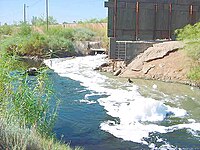
Photo from wikipedia
Microplastic pollution is a growing problem for Turkey and other countries, but most studies focus on the pollution in oceans and seas. To understand the relationship between microplastics, fresh water,… Click to show full abstract
Microplastic pollution is a growing problem for Turkey and other countries, but most studies focus on the pollution in oceans and seas. To understand the relationship between microplastics, fresh water, and terrestrial environment, we examined Pelophylax ridibundus and Rana macrocnemis tadpoles that can inhabit a wide range of both terrestrial and aquatic habitats, ecoregions and elevations, and that are members of Ranidae family. We characterized microplastics (MPs) in sediments, surface water, and tadpoles from the Rize province in northeastern of Turkey. The content of MPs in sediments, surface water, and tadpoles, ranged 64.17-472.1 items/kg, 1-13 items/L and 302.62-306.69 items/g, respectively. In sediment samples, polypropylene (PP) and polyethylene (PE) were the dominant pollutants; whereas, nylon and polyethylene terephthalate (PET) were found in surface water. In tadpoles, PET, nylon, and polyacrylic were the dominant MPs.
Journal Title: Chemosphere
Year Published: 2020
Link to full text (if available)
Share on Social Media: Sign Up to like & get
recommendations!